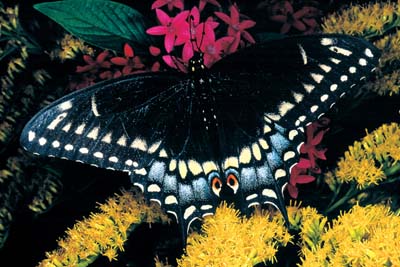Parsleyworm / black swallowtail, Papilio polyxenes
(Lepidoptera: Papilionidae)
Black swallowtail (the larval stage is known as parsleyworm or celeryworm) is found in southern Canada and the eastern United States as far west as the Rocky Mountains. Its range also extends south into Mexico and northern South America. There are three generations annually in warm climates, fewer in the north. Overwintering occurs in the pupal stage, and in warm climates some pupae from the second generation, as well as all those from the third generation, enter diapause and emerge the following spring. Eggs are deposited singly on leaves and flowers of host plants, and hatch in four to nine days. The color pattern among individuals and among the five instars is variable, but the general pattern is as follows: The first three instars are bird dropping mimics, principally black in color with a spot resembling a saddle on the third and fourth abdominal segments. The fourth instar is principally black, but the anterior and posterior of each body segment is edged in green, and there are orange or yellow spots located near the center of each body segment. The fifth instar is predominantly green, with black restricted to the center of each segment; this stage also has the orange spots found on the earlier instar. The pupa is attached with silk to a plant stem. Adults of black swallowtail are principally black in color, but a row of yellow spots is found near the margin of the wings. Both sexes bear, at the posterior margin of the hind wing, an elongation of the wing that forms a "tail." The adults are quite large, the wingspan measuring over 7 cm. Adults are active during most of the day, and males are territorial, defending areas against other males.
Larvae feed on plants in the family Umbelliferae, such as carrot, celery, fennel, parsley, and parsnip. The herbs anise, caraway, and dill also are eaten. Numerous umbelliferous weeds serve as suitable hosts, including angelica, cow parsnip, lovage, water hemlock, and wild carrot. There are some chemical similarities between Umbelliferae and Rutaceae, the plant family containing citrus. Thus, occasionally these swallowtails will be observed feeding on citrus, particularly orange trees. Adults visit a variety of flowers to obtain nectar, but seem particularly fond of milkweed, thistle, and red clover. Larvae are large and can consume considerable quantities of foliage toward the end of their development. They are of concern only in the home garden, because the butterflies are not sufficiently abundant ever to threaten commercial cultivation of an umbelliferous crop. Hand picking is usually recommended in the home garden. In instances where plot size is too great to make this practical, larvae can be killed easily with foliar insecticides, either chemical or Bacillus thuringiensis.
Images
To save the Web-optimized images shown below to your hard drive:
PC users: right click to "Save Picture (or Image) As..."
Mac users: click and drag to your desktop.
Copyright © 2005 University of Florida
